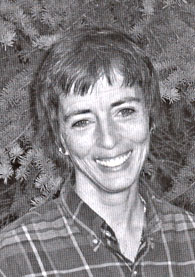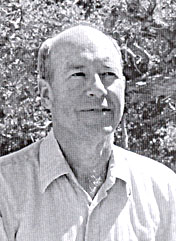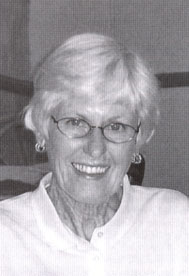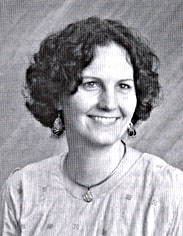Embracing the Feminine: A Search for Meaning and Healing
By Annie Kaufman
 My life began as a religious journey and has evolved as a process of spiritual growth. As a little girl my mother took me and my sisters to the Methodist Church. I was confirmed as a Methodist, and received my Bible before we moved away in 1965, when I was nine years old.
My life began as a religious journey and has evolved as a process of spiritual growth. As a little girl my mother took me and my sisters to the Methodist Church. I was confirmed as a Methodist, and received my Bible before we moved away in 1965, when I was nine years old.
After my parents divorced, my mother took us to a Catholic church where I went to catechism and was baptized. Later, while in high school, I became a Mormon. As a Mormon, I wanted to broaden my education, so I studied complicated works from assorted lists of the "best books" one could read. I began my studies and searched for the meaning of my life with fierce diligence, believing this would help me cope with my childhood phobia of people. My list of books included chosen works by Hesse, Thomas Mann, and Dostoevsky.
Later, I spent a year and a half as a missionary in Ecuador. This helped me grow beyond my love affair with the Mormons and at the age of twenty-five, I left the Mormon Church, feeling its structure and rules did not truly help me with my discomfort in social situations. I still pored over spiritual texts and self-help books looking for answers to my struggle with anxiety. I used meditation, mindfulness, the medical profession, and other healing techniques to deal with this emotion and the physical ailments that accompany it.
During this period of study and contemplation which was partly due to illness, I became conscious of my connection with the planet. I was fascinated with the experience of expanded consciousness that occurred when reading inspiring literature and when I was alone in nature. Feeling my energy merge with my surroundings, I realized I could communicate with plants, animals, and objects especially when I walked and played my Native American flute. This experience of merging with nature became a source of healing and nurture in my otherwise chaotic world.
H. P. Blavatsky writes about "invisible intelligent Existences" in The Secret Doctrine (611) and refers to electricity and all the forces of light and heat as "gods" and indicates this understanding of energy was taught by the ancient Egyptians and the Hindus. These and other cultures have their stories of gnomes, geniis, little people, fairies, and the like which modern society dismisses as superstition.
Such entities are actually representatives of these invisible powers and are diverse expressions of the way the powers have always looked to, or been described by, the humans with whom they communicate. Through plants, animals, the wind, and other forces of nature, we see reflections here on earth both of our political chaos and the chaos in our souls.
I tried to understand my metaphysical experiences by studying science: basic quantum physics, genetics, and Western medicine. I wanted to know how the experiences of dreams and insights that were so astounding to me and touched my life occurred. I wanted to know intellectually why Einstein searched for a unifying principle; as I hoped this would explain what I felt intuitively.
The University of Chicago's Masters in Liberal Arts program provided me the opportunity to continue my multi-faceted investigation of what I now called the Universe. I received little support in my pursuits from peers and friends, who asked: "What will you do with that degree?" They wanted to know, I think, how it was going to translate into monetary value in my life. I explained I had already made the changes in my career that I felt were most beneficial to me, such as working part-time as a nurse. I found that the healing part of my experience and studies is what has been of greatest import in my life. The Masters program also introduced me to film-making as a way of journaling my experiences as they happened, which I felt was very important in my healing process.
Given the response I normally received when the topic came up, I did not talk about the Masters program. However, it introduced me to the Bhagavad Gita, an ancient Hindu scripture, and this book became part of the focus for my Masters project. In class, I recommended reading a chapter or parts of the book straight through and aloud, for hearing it spoken gave a richer sense of its original feeling and rhythm as well as its place in the culture in which it was created.
I knew I wanted to complete my project, both the film and the thesis, in a style that was attentive to both the moment and could direct the readers' attention to themselves. I had read Walden in high school, and Thoreau exemplified this approach to living, attending to and documenting what he saw and his connection to the universe. By discussing Walden along with the Bhagavad Gita in my project and documentary, I found a way to describe why I was looking at the right-brained thinking as a path to experiencing the interconnected web of life. I felt that this feminine thinking style, when squashed, leads to mental illness. This had been my experience and I wanted to demonstrate that when nurtured, this connection to the feminine leads to healing of both body and soul.
I created a documentary called Dostoevsky, the Gita, Walden and Anne to display this thinking style. It was inspired in part by an incident that happened at the Theosophical Society in Wheaton. During a weekend workshop on music and healing with Don Campbell, I was asked to respond to a small white box, the kind you get at the jewelry store when you buy a pair of earrings. Inside my box was a seed, a string, a blade of grass, and the smiling face of boy cut out from a magazine. I decided to dance in response to the box and found a copy of Pachelbel's Canon to dance to. As I danced, I knew this would be the first dance I would use in my film project. Using my understanding of the Bhagavad Gita as a springboard, I divided the movie into three parts, three being a sacred number, with "The Seed" representing creation and the beginning; "The Fruit of Life" describing reality in life's middle, and "Dissolution" representing death and destruction.
I filmed the first dance on the deck just outside my front door. In the second dance, I hummed an accompaniment to the Canon, dancing in between two mirrors in my bathroom so that my arms represent the many arms of Shiva, the Indian god of destruction. The last dance completes life's cycle, and to my surprise my neighbor walked by with his dog as I was filming late at night. I wanted to stop dancing, but the beginning of the dance had worked so well that I kept going. Later I read that Aesclepius, the Greek god of healing has a dog as his companion. Realizing this, I decided it was fitting to leave him and his dog in the film.
While showing my movie to friends and discussing it at the Theosophical Society, I realized I wanted to read The Secret Doctrine. Reading the Gita aloud in class was really an introductory step that led to reading The Secret Doctrine straight through. I realized it had been written and intentionally organized as a book, so that was the way I wanted to read it. I had started attending a Spiritualist Church and when I found that HPB met Colonel Olcott at a Spiritualist meeting in New York, I realized that my new interests, both in Spiritualism and in her book, were intertwining in an interesting way.
Seeing me with the book, a few of the staff at Olcott expressed incredulity, "Nobody reads The Secret Doctrine, at least not straight through!" I replied jokingly, "I said I was going to read it, not understand it." Then, when checking it out for the third or fourth time from the library, the librarian said, "You don't read that book straight through," to which I replied "Yes, you do, or I mean, you can!" (By then I was beginning to doubt myself and wondered if this project was beyond me after all.)
At first I found the book to be boring, technical, and disorganized. Even though I recognized this as what I expected right-brained writing would be like, I didn't find that my own propensity to write in this seemingly disconnected style made reading or understanding it any easier. Throughout The Secret Doctrine, HPB constantly moves from topic to topic. She might begin by discussing seven rays of energy or consciousness, and then shift to discussing different entities while throwing in the wisdom of the Chaldean peoples of Mesopotamia and the Semites and Egyptians of antiquity! Having read so many books, she referenced famous and obscure thinkers with whom I had little connection, decrying or exclaiming over thoughts by Descartes, Kant, Aristotle, Plato, Leibniz, and a certain Professor Crookes, among others.
In the end, I decided to tackle this book as I had tackled the works I had read in quantum physics or biology: I simply plowed through. I just kept going, and though still aware of the dryness, I stayed alert for the little pearls of wisdom interspersed among the difficult parts.
Then I noticed something quite unique: After the first three or four months—and about four hundred pages or so into the book—as I started flipping back to remind myself where HPB had been or what connection or line of thought she was following, the information on the previous pages seemed to rise up off the page, alive with new clarity, insight, and, yes, delight. This amazed me and it was not an occasional experience. I found it breathtaking. A friend commented that perhaps I had needed the overview in order to see HPB's ideas clearly when I returned to them from a point later on in the book. I am still not sure, but every time I looked at something I had already read, it seemed to have this new sparkle, this new freshness, about it.
I realized I was learning a great deal, and in my mind, I put together an amazing connection between Ancient Wisdom and my questions about the interconnected web of life. At the time, I was also reading Neil Douglas-Klotz's Desert Wisdom, which deals with creation religions that celebrate cosmogony, or the beginning of time, in scripture, song, and practice. As this is also the subject of The Secret Doctrine, the two studies went together, hand in hand.
Reading The Secret Doctrine and Desert Wisdom together, I realized how over time the feminine principle or the aspect of spirituality has been erased from the external forms of so many of today's world religions While I belonged to three different Christian churches, I had also read Judaism, Islam, the Tibetan Book of the Dead, Zen and Buddhism. I discovered that the ancient teachings string these ancient philosophical systems together and reconcile them. Tidbits of this information are to be found scattered in Egyptian papyri and in isolated sentences in the Tibetan Book of the Dead.
While reviewing these diverse descriptions of our beginnings, I found it comforting to know that between universes, consciousness is not lost. As HPB says,
Everything will have re-entered the Great Breath . . . reabsorption is by no means such a "dreamless sleep," but, on the contrary, absolute existence, an unconditioned unity, or a state, to describe which human language is absolutely and hopelessly inadequate. . . Nor is the individuality—nor even the essence of the personality, if any be left behind" lost, because reabsorbed. . . the same monad will re-emerge therefrom, as a still higher being, on a far higher plane, to recommence its cycle of perfected activity.
From a human perspective, each of these universes last billions of years, and I'm not sure why this thought comforted me, except perhaps that I also know that all the universes and time exist in the breath of the One. Our time—our universe—although real to us, is actually an experience of that oneness in all its aspects; a oneness that exists outside of time.
I think about this paradox as I move through life; that life is real and in the same moment, it is not real. Life has more to do with the process than with the material items we find around us. These material things, the trees, rocks, and the glories of nature, are an extension of our consciousness and as all was created, so it all exists in time and through eternity, as a point or movement in the breath of the One—or Fohat—as HPB mentions in her books.
Space opens up when it is observed, and in the beginning, from a point in eternity, all was created. The circle was created, and one human being, itself a reflection of that first point, looked to the horizon and saw that it was round.
I was celebrating the circle at a Universal Dances for Peace gathering recently and as we danced, we read a Hebrew verse from Proverbs about the beginning, which was rendered in beautiful calligraphy on a poster on the wall. The verse concerns Sacred Wisdom, also called Hokmah or Sophia in other traditions, which first desired creation and so poured herself out into the ground of being. Spinning in both directions, she created the universe. This sort of feminine beginning describes creation in most of the ancient traditions I have studied.
The Secret Doctrine mentions this spinning in that centrifugal and centripetal forces are the primary forces allowing creation to occur. The caduceus is a symbol of this one becoming two and the spinning is represented in the two snakes twining around each other in opposite directions. Thus is our fragile creation, created from and around a no-thing by the Fohat, or eternal presence, represented and taught by cultures, ancient and modern alike, arising out of the feminine aspect which was created when the one decided to become two.
H PB says when someone dies, the active agent which keeps the body alive is transformed; the preserver is transformed into the destroyer. The dissolution I danced as part three of my film is an inherent part of our process. We separate events into good and evil, constructive and destructive, and by siding ourselves with one, we create the "other" outside of ourselves with whom we then fight. Through our faiths and spiritual practices we experience the oneness I described earlier. But the difficulty comes when we try to deal with the split and the resulting differentiation—when one becomes two, male and female—and we start judging which is best. We think light is better than dark; that light is good, darkness evil. These qualities are part of the split in the origin of the universe, nothing more. When the forces are out of balance, it means the destructive force is out of balance, and we experience disharmony and discord. This view of life as opposition, with white representing good and black evil, creates strife. We can change our cultural perspective by choosing to use different symbols.
Life is more like a wheel with spokes than an endless array of opposites. These spokes can extend from the same center to create all sorts of positions on the circle of life. It is difficult for humans when their spiritual paths insist on one of these forces as being the only right one. This leads to strife and conflict. We struggle internally over what we deem to be right and true, and our own destructive forces use this struggle to create chaos around us.
Adding the feminine to the picture helps us create balance and harmony. Remember that Sacred Wisdom, Hokmah or Sophia, desired creation and that this being was one. Referring back to the scripture I mentioned earlier, by pouring out the one became two, and with the creation of matter there were now three. This split in the forces of male and female creates and brings forth the child. These forces are also two: creation and destruction, birth and death. These two intertwine around this creation, as the clockwise and counterclockwise spirals. When one of the forces shifts strongly out of balance, eventually its very state of imbalance brings about an opposing reaction.
We have been in throes of penetrating masculine energy at the expense of our nurturing feminine side. Our culture has been based on opposites: right and wrong, plus and minus, action and reaction. Our misguided interpretation of Newtonian physics is now being corrected by quantum physics in which uncertainty and probability can now be discussed. By using the sacred circle, we can see there are many spokes on the wheel connecting us to all the positions on any given topic. If we change our mentality from "us and them" to "me and all others, who are also me," we may be able to effect real change on this planet.
Now I often sit and let my personal battle rage within me without doing or changing anything in my relationships. I remind myself to look at what my situation is today, for example, by checking in with my significant other instead of making decisions without his input. I struggle to remain kind to the people around me, because this is what I can do. I engage others with kindness as often as I can. I find that while the kindness has not changed them, it has changed me. And sooner or later, my soul's position changes, possibly because I have continued to love from where I am.
I remember what HPB said about levels of consciousness, that higher means less material, not necessarily better, and I try not to judge who is right and who is wrong. In this, I am guided by what I now know was present in the beginning, feminine receptive Wisdom and Mystery. And in the words of my dear friend Verena, who is in her seventies, "ever since I met Sacred Mystery, I have been joyful."




